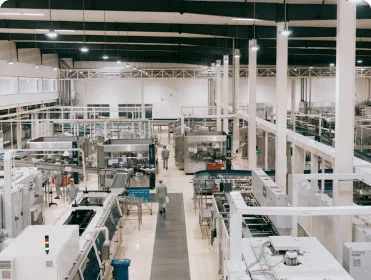IoT-Enabled Smart Manufacturing: Revolutionizing Production Efficiency
Executive Summary
In the era of Industry 4.0, manufacturing companies are increasingly turning to Internet of Things (IoT) technologies to enhance operational efficiency, reduce costs, and improve product quality. HawksCode, leveraging its expertise in IoT, data analytics, and artificial intelligence, undertook a transformative project to develop a comprehensive smart manufacturing solution for a global manufacturing conglomerate. This case study explores the implementation of an interconnected ecosystem of sensors and analytics tools that revolutionized production efficiency across multiple facilities.
Industry Context and Challenges

Operational Inefficiencies:
Traditional manufacturing processes often suffer from bottlenecks, downtime, and resource wastage.
Quality Control:
Maintaining consistent product quality across large-scale operations is challenging with traditional methods.
Predictive Maintenance:
Reactive maintenance approaches lead to unexpected downtime and increased costs.
Supply Chain Visibility:
Lack of real-time insights into inventory levels and supply chain operations hinders optimal resource allocation.
Energy Management:
Inefficient energy usage contributes to high operational costs and environmental impact.
Data Silos
Disparate systems and lack of data integration prevent holistic operational visibility.
HawksCode's Innovative Approach
Recognizing the multifaceted nature of these challenges, HawksCode developed a comprehensive, IoT-driven smart manufacturing solution. Our approach encompassed several key components:
01
IoT Sensor Network Deployment
Challenge
Solution:
- Deployed a comprehensive network of IoT sensors across manufacturing facilities.
- Implemented edge computing devices for local data processing and filtering.
- Developed a secure IoT gateway for data aggregation and transmission to the cloud.
Technical Deep Dive:
- Utilized industrial-grade sensors from vendors like Siemens and ABB, capable of withstanding harsh manufacturing environments.
- Implemented edge computing using Dell Edge Gateways running Ubuntu Core, with custom applications developed in Python for data preprocessing and anomaly detection.
- Developed a secure IoT gateway using AWS IoT Greengrass, enabling local execution of Lambda functions and machine learning models.
02
Real-time Data Analytics Platform
Challenge
Solution:
- Developed a scalable, cloud-based data analytics platform.
- Implemented real-time data processing pipelines for immediate insights.
- Created customizable dashboards for different stakeholders (operators, managers, executives).
Technical Deep Dive:
- Utilized AWS IoT Core for secure device connectivity and data ingestion.
- Implemented Apache Kafka on Amazon MSK (Managed Streaming for Apache Kafka) for high-throughput, real-time data streaming.
- Developed data processing pipelines using Apache Flink on Amazon Kinesis Data Analytics for real-time analytics.
- Created a data lake using Amazon S3 and AWS Glue for data cataloging and ETL processes.
03
Predictive Maintenance System
Challenge
Solution:
- Developed machine learning models to predict equipment failures before they occur.
- Implemented a condition-based maintenance system.
- Created a maintenance scheduling and resource allocation module.
Technical Deep Dive:
- Implemented feature engineering pipelines using Apache Spark on Amazon EMR to process historical maintenance data and sensor readings.
- Developed a custom maintenance optimization algorithm using genetic algorithms, implemented in Python and deployed as an AWS Lambda function.
- Created a real-time alerting system using Amazon SNS (Simple Notification Service) to notify maintenance teams of impending issues.
04
Quality Control and Process Optimization
Challenge
Solution:
- Implemented computer vision systems for automated quality inspection.
- Developed process optimization algorithms using reinforcement learning.
- Created digital twins of manufacturing processes for simulation and optimization.
Technical Deep Dive:
- Utilized AWS Panorama for deploying computer vision models at the edge, with custom deep learning models trained using TensorFlow for defect detection.
- Implemented reinforcement learning algorithms using OpenAI Gym and Ray for process optimization, deployed on Amazon SageMaker.
- Developed digital twins using Siemens MindSphere, integrated with AWS IoT TwinMaker for comprehensive simulation and visualization of manufacturing processes.
05
Supply Chain Integration and Optimization
Challenge
Solution:
- Integrated IoT data with supply chain management systems.
- Implemented predictive analytics for demand forecasting and inventory optimization.
- Developed a blockchain-based system for supply chain traceability.
Technical Deep Dive:
- Utilized AWS IoT SiteWise for collecting, processing, and monitoring industrial equipment data across facilities.
- Implemented advanced demand forecasting models using Prophet and neural networks, deployed on Amazon SageMaker.
- Developed a custom inventory optimization algorithm using stochastic programming, implemented in Python and integrated with existing ERP systems.
Implementation and Change Management
01
Phased Rollout
Implemented the solution in carefully planned phases, starting with a pilot program in a single facility before expanding to others.
02
Stakeholder Engagement:
Conducted workshops and training sessions with operators, managers, and executives to gather requirements and address concerns.
03
Change Champions:
Identified and empowered change champions within each facility to drive adoption and provide local support.
04
Integration Support:
Provided dedicated technical support teams to assist with integration of IoT solutions with existing manufacturing systems.
05
Feedback Loops:
Established regular feedback sessions and improvement cycles to continuously enhance the system based on user experiences.
06
Data-Driven Culture
Promoted a data-driven decision-making culture through leadership workshops and success story sharing.
Results and Impact
1. Operational Efficiency:
- 25% increase in overall equipment effectiveness (OEE).
- 30% reduction in unplanned downtime.
- 20% improvement in production throughput..
2. Quality Control:
- 40% reduction in defect rates.
- 50% decrease in quality control-related costs.
- 99.9% first-pass yield achieved for critical products.
3. Predictive Maintenance:
- 35% reduction in maintenance costs.
- 60% decrease in unexpected equipment failures.
- 20% extension of average equipment lifespan.
4. Supply Chain Optimization:
- 30% reduction in inventory holding costs.
- 25% improvement in on-time deliveries.
- 15% reduction in procurement costs through optimized sourcing.
5. Energy Management:
- 20% reduction in overall energy consumption.
- 30% decrease in peak energy demand.
- 40% increase in renewable energy utilization.
6. Workforce Safety and Productivity:
- 50% reduction in workplace safety incidents.
- 30% improvement in worker productivity.
- 25% reduction in training time for new employees.
7. Data-Driven Decision Making:
- 60% reduction in time spent on manual reporting.
- 40% improvement in forecast accuracy for production planning.
- 90% of operational decisions now based on real-time data insights.
8. Financial Impact:
- 15% reduction in overall manufacturing costs.
- 20% increase in profit margins.
- ROI achieved within 18 months of full implementation.
Lessons Learned and Best Practices
1. Start with Clear Objectives:
2. Prioritize Cybersecurity:
3. Embrace Edge Computing:
4. Ensure Scalability
5. Focus on Data Quality
6. Promote Cross-Functional Collaboration:
7. Invest in Change Management
8. Consider Interoperability:
Conclusion
The successful implementation of HawksCode's IoT-enabled smart manufacturing solution demonstrates our ability to leverage cutting-edge technologies to transform traditional manufacturing operations. By combining deep industry knowledge with advanced IoT, data analytics, and AI expertise, we delivered a comprehensive solution that not only optimized current processes but also positioned our client at the forefront of Industry 4.0 innovation.

This case study showcases HawksCode's capabilities in:
- Large-scale IoT sensor network deployment and management
- Real-time data analytics and visualization in industrial settings/li>
- Development of AI and machine learning models for manufacturing optimization
- Integration of IoT solutions with existing manufacturing and ERP systems
- Implementation of digital twins and advanced simulation technologies
- Blockchain implementation for supply chain traceability
- AR and wearable technology integration for workforce safety and efficiency
As the manufacturing landscape continues to evolve, HawksCode remains committed to driving innovation and efficiency through smart, connected solutions. Our holistic approach, combining technological expertise with strategic industry insights, enables us to deliver transformative IoT solutions that drive tangible, long-lasting value for our clients in the manufacturing sector and beyond.






